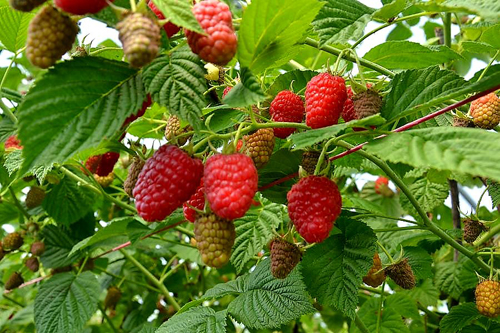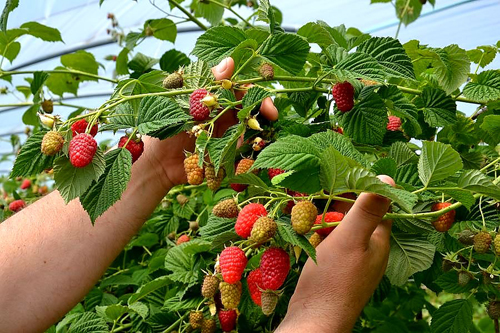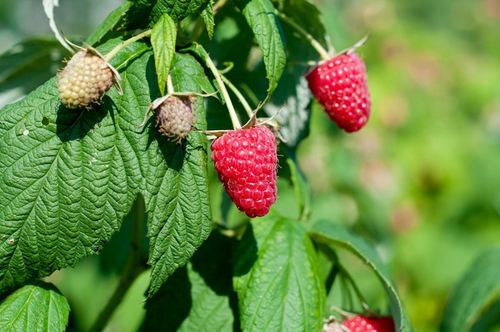Raspberry variety Lyachka (Lyashka)
This raspberry some 8-10 years ago was one of the most desired and anticipated novelties among the "advanced" gardeners and nursery growers. And ordinary summer residents, following the trends in the world berry life, dreamed of this variety. And it is not at all surprising that our heroine from Poland quickly spread across the territory of Ukraine, Belarus and Russia. In the original, raspberries are called Laszka. This word, which is unusual for us, has many variants of reading in Russian: Lyashka, Lyachka, Lashka, Lachka. Closer to the truth and more correct Lashka. And more familiar and more famous with us is Lyachka. But the essence of the variety will not change if you pronounce its name correctly. You should be more worried about who bought the planting material and whether it is really the original, and not a banal re-grading, and how to successfully grow a large bush richly fruiting with tasty berries from a small seedling. But whether the Pole-Lyachka really lived up to the hopes placed on her - about this in our article below.

History of creation
The summer raspberry variety Laszka comes from Sadowniczym Zakładzie Doświadczalnym Instytutu Sadownictwa i Kwiaciarstwa in Brzezna, Poland. It was bred by the world famous breeder Dr. Jan Danek, who is the author of many berry masterpieces. According to some reports, Dr. Agnezhka Orzel partially helped him in this. She would later become his co-author in breeding the flagships of the Polish raspberry industry - the varieties of Radziev, Sokolitsa and quite another novelty of Pshekhib. Already in 2003, Danek and Markovsky characterize the new variety as a very fruitful, early, dessert variety with a high content of ascorbic acid. Lyachka is included in the State Register of Varieties of Poland
By the way, J. Danek and A. Orzel, together with a number of other Polish scientists, are now working in a young but very ambitious Polish company. This is Niwa Berry Breeding Company Ltd, founded in 2012 and based in Brzezna. Niwa is launching the first private program in Poland to develop new varieties of berry crops.
Description
Lyashka is a licensed Polish dessert raspberry of a very early ripening period. Fruiting on overwintered two-year-old shoots. For a long time she was the standard for early maturity. When grown in tunnels, the berries can be harvested at the end of May. Ripens in the southern regions in the first decade of June, but already in the Middle zone - in the first decade of July. For example, in Poland, the collection starts from June 15, and more often after June 20, in the center and in the north of Ukraine from about the same numbers, and in the south of Siberia from the beginning of July. Polish varieties similar to Lyachka in terms of ripening - Sokolitsa and Pshekhiba. Radzieva sings a week earlier, and in the tunnels - 10 days. Interestingly, the Poles themselves are positioning Sokolica as a replacement for our heroine in the future.

The bush is tall, has a powerful growth force, produces quite a lot of shoots, mostly 1.7-2.0 meters high. But with good agricultural technology and timely watering at the time of active growing season, it can easily reach 2.5-3.0 meters. The stems themselves are rigid, erect, but closer to the apex they bend arcuately. The shoots of Lyachki are relatively densely covered with thorns. But the thorns are small, straight, not aggressive, greenish-purple in color. Biennial shoots produce many medium-length fruit branches - laterals. To maintain high commercial characteristics, it is required to normalize shoots and leave 7-10 pieces per linear meter or 3-5 stems in a bush.
Stems are medium-thick, generally 1.5-2.5 cm in diameter, with medium-length internodes, covered with a slight waxy coating. Young shoots are juicy green. By winter, the shoots of the first year ripen and acquire a brownish-anthocyanin hue. Root shoots of raspberries are medium, in spring the nettles can be with a lemon or anthocyanin shade.
Under the weight of many berries, Lyashka's tall shoots can lean to the ground, the bush seems to fall apart.Therefore, for the successful cultivation of the variety and in order to avoid losses in the yield, it is necessary to install trellises or supports. The optimal height of the trellis should be 1.70-2.0 meters, with 2-3 rows of wire or strong rope stretched. The distance between the posts is up to 10 meters, but if possible, it is advisable to set them more often, after about 5 meters. The pillars are buried in the ground to a depth of 50 cm.
Raspberry leaves are medium and large, oval, slightly twisted, corrugated, strongly toothed edges. The leaf consists mainly of three, rarely five leaves. They are slightly pubescent, dark green above, and whitish below. Lyachka begins to bloom in the second half of May. Flowers are white, medium-large, 1.5-2 cm in diameter, collected in numerous, but small brushes.

Fruits are elongated-cylindrical and broadly blunt-conical (triangular) in shape. The nose of the berries is blunt, rounded. The length of the fruits is on average 2.5-3 cm, with competent agricultural technology it often reaches 4-5 cm. The width is mainly 2-2.5 cm. Lyachki berries are fleshy, large and very large, beautiful, showy and one-dimensional. Mostly leveled, the percentage of curved and deformed berries is low. The average weight of fruits in the season is 5-7 grams, but often they can be poured up to 10 grams. According to the comparative characteristics carried out in 2013 in Brzezna, the weight of 20 Lyashka berries was 83 grams (from a scientific article by A. Orzel).
Raspberry berries are bright, rich orange-red color, when fully ripe they acquire a raspberry color. They are sparsely pubescent and sometimes can be with a slight bluish bloom on the skin. Fruits are firm, firm, but with juicy pulp. Drupes are small, tightly interconnected. The bones in them are very small, almost imperceptible when used. The fruiting period of the variety is slightly stretched and is 4-5 weeks. The berries are easily removed from the fruit plant, with a dry separation, do not flow. When overripe, they can crumble from the bush and lose marketability, in particular, keeping quality and transportability deteriorate. Therefore, Lyashka requires regular samples.
What else is notable for Lyachka is really high tasting characteristics. The expert's assessment was 9 out of 10 possible points; the fruits have a well-balanced sugar and acidity. The berries are tasty, sweet, but without cloying, with a slight pleasant sourness and a good raspberry aroma. The taste is close to the classic raspberry, as it should be in our mind. In 2014, NIWA Berry Breeding Ltd., Brzezna, evaluated the acidity, soluble solids and ascorbic acid content of Laczka raspberries. According to Agnezka Orzel, the percentage of titrated acids was 1.7%, the BRIX sugar level was 10.0%, and the ascorbic acid content was 49.0 mg / 100 g-1.

The fruits of universal use. They are used for sales in the markets of fresh berries and for personal use. Good for freezing. After defrosting, they do not significantly lose their density, do not spread - they retain their shape. Also, berries are used for drying, in all kinds of processing - preserves, jams, compotes, marmalades, syrups. And, of course, in a variety of desserts and pastries. Lyachki berries are especially suitable for these purposes, due to their very small seeds in the drupes and their high sugar content.
The variety has normal keeping quality and transportability. For commercial purposes, sampling should be carried out almost every day - every other day, when the berry is orange-red. When overripe, it acquires a rich crimson color. Indicators of taste and sugar in raspberries are improved, and transportability and shelf life are correspondingly reduced. Without refrigeration, the tested shelf life indicators are 1 day with the preservation of all marketable qualities. Maximum - two days. Then the berry begins to crumple and leak. With proper cooling and storage in the refrigerator, storage rates increase up to 4 days.
A variety of great economic importance on a pan-European scale. Especially suitable for direct sales of berries. I can be successfully grown in greenhouses - tunnels, greenhouses.The yield from one bush is mainly 4-6 kg, depending on agricultural technology and plant age. On an industrial scale, productivity is 17-20 tons per hectare.

Lyachka belongs to those varieties that, without proper and proper care, will not show a significant share of the potential laid down by breeders. Very big potential. For its disclosure, intensive agricultural technology is required, including complete protection against diseases (especially fungal) and pests. For Lyashka, this is very important, since she can suffer from aphids, spider mites and stem gall midges. There are frequent cases of severe damage to didimella (purple spot). Raspberries are also vulnerable to a more serious disease - root cancer. Relatively resistant to gray mold.
Timely watering in the proper amount is also important, our heroine does not differ in heat and drought resistance. With a lack of moisture, especially at the time of fruiting, the size of the fruits and their taste can be significantly reduced. In the direct scorching sun, ripe fruits can be baked.
For good transportability and keeping quality, as well as generally for a consistently large size of fruits and high yields of raspberries in general, a balanced "feeding" is necessary. This is the provision of the plant in full with the necessary amount of micro- and macroelements, especially at the time of ripening of berries.
It is important for the variety that the plantings are not thickened, they must be well ventilated. And the plantation itself should be located in a place well-lit by the sun. It is highly desirable to create optimal soil conditions. Lyachka prefers nutritious, loose and slightly acidic soil. Recommended planting scheme: 0.4-0.6 meters between plants in a row, minimum row spacing - 2 meters, preferably 2.5-3 meters, especially if mechanized collection is envisaged. The greater the distance between the rows, the easier it is to collect and maintain.
The frost resistance of the variety is normal, up to -30 ° C. But freezing of the shoots, and especially the buds, is possible. The frost resistance of Lyachki is badly affected by temperature swings - thaws with a positive temperature, and then their abrupt change to a serious minus. In remontant and early summer varieties, buds begin to wake up early at positive temperatures, the plant prepares for the beginning of the new season. And a serious drop in temperature can even lead to their complete freezing. So raspberries in regions with consistently low temperatures and heavy snowfalls sometimes winters better than in the southern regions.
Therefore, it is imperative for the winter to bend and bunch the stems with each other, and in regions with little snowy winters - a shelter with protective material, for example, agrofibre. The frost resistance of raspberries, and in particular Lyachka, is influenced by the general sanitary condition of the plants. With a significant infection with fungal diseases, resistance to low winter temperatures drops significantly. Therefore, in the fall, it is recommended to carry out the treatment with fungicides and to make a sub-winter moisture charge of the soil. And also to monitor the sufficient provision of moisture during the entire autumn period. This will help Lyashka to fully develop and "ripen" the shoots faster, to prepare the whole plant for wintering.
Weak sides
- It is not uncommon to come across deformed and slightly curved berries. But this does not spoil the overall picture.
- The variety is very sensitive to the frequency of watering, especially at the time of fruiting, with a lack of moisture, the fruits quickly become smaller.
- A thick grayish bloom may form on the berries.
- The intense heat significantly affects the size of the berries. Also, Lyachki fruits can be baked in the sun. Shading is desirable at the time of fruiting.
- Raspberries require frequent sampling, fruits overripe quickly and can crumble.
- When fully ripe, the berry gains maximum juiciness, taste and sugar. But transportability and keeping quality are accordingly greatly reduced.
- Agrotechnology does not require anything special or outrageous, but must be strictly implemented. And there must be a high soil agrophone.
- Shoots are densely covered with thorns, but they are small and not aggressive.
- The variety requires an obligatory garter to the trellis.
- Lyachka is poorly resistant to some diseases and pests.
- With good frost resistance of the shoots, freezing of the buds is possible.
Strengths
- Lyashka berries have an undeniable "wow effect", beautiful, large and very large.
- In the market, this raspberry is in high demand, in a simple way - the berries are not just sold, but "fly away".
- The fruits are dense, the drupes are uniform, tightly linked, the seeds are very small.
- The versatility of the use of fruits.
- The crop has good keeping quality and transportability.
- Lyachka is one of the earliest in terms of ripening among summer raspberries.
- High taste, high sugar content in fruits, good raspberry aroma.
- High yield rates, suitability for growing in greenhouses.
- The variety is equally good for both an ordinary summer resident and a large farmer.
Author: Maxim Zarechny.









IT'S NOT CLEAR WHAT IS "WOW-EFFECT" ...